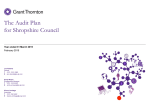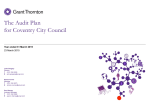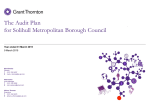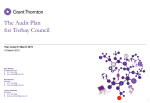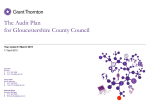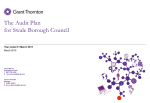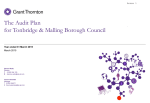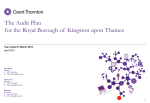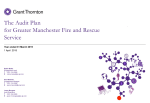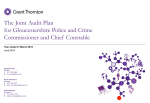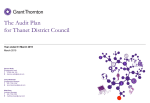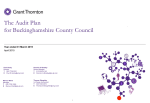Download The Audit Plan – template user guide
Transcript
AGENDA ITEM NO 5 The Audit Plan for South Staffordshire Council Year ended 31 March 2015 February 2015 Mark Stocks Director T 0121 232 5437 E [email protected] Emily Mayne Audit Manager T 0121 232 5309 E [email protected] Tom Joy Associate T 0121 232 5179 E [email protected] © 2015 Grant Thornton UK LLP | South Staffordshire Council 2014-15 | February 2015 Contents Section 1. Understanding your business 3 2. Developments relevant to your business and the audit 4 3. Our audit approach 5 4. Significant risks identified 6 5. Other risks identified 7 6. Value for Money 9 7. Results of interim work 10 8. Key dates 12 9. Fees and independence 13 10. Communication of audit matters with those charged with governance 14 The contents of this report relate only to the matters which have come to our attention, which we believe need to be reported to you as part of our audit process. It is not a comprehensive record of all the relevant matters, which may be subject to change, and in particular we cannot be held responsible to you for reporting all of the risks which may affect the Council or any weaknesses in your internal controls. This report has been prepared solely for your benefit and should not be quoted in whole or in part without our prior written consent. We do not accept any responsibility for any loss occasioned to any third party acting, or refraining from acting on the basis of the content of this report, as this report was not prepared for, nor intended for, any other purpose. © 2015 Grant Thornton UK LLP | South Staffordshire Council 2014-15 | February 2015 Understanding your business In planning our audit we need to understand the challenges and opportunities the Council is facing. We set out a summary of our understanding below. Challenges/opportunities 1. LG Finance Settlement 2. Innovative service delivery 3. Alternative Delivery Models The local government spending settlement showed local authorities are facing a cash reduction in their spending power of 6% in 2015/16. Savings need to be recurrent and have a long term impact. Improved procurement to deliver efficiency savings. Moving from the provision to the commissioning of services where financially more advantageous. Growing income generation in new areas to counteract the impact of the economic downturn. Development of local authority trading companies and joint ventures to support Council ambitions. Partnership working with other bodies and the voluntary sector. 4. Threat to Green Belt Protection of the Green Belt remains one of the Council’s key strategic priorities. The release of land for housing and employment development remains a core pressure and the Council has agreed a Core Strategy Development Plan which was submitted to central government in 2011. 5. Demographic trends – aging population 6. Officer capacity The Council has a Voluntary Redundancy (VR) programme in place as part of its financial strategy. Reduced staffing levels puts greater pressure on Officers continuing in post. The Director of Finance took VR on 31 December 2015. Responsibilities were reassigned to existing staff. We will assess the Council’s management capacity to deal with the challenges it faces to inform our 2014/15 value for money conclusion. We will review the financial planning process and consider how the split of overall financial responsibility and the Section 151 role supports this process. South Staffordshire has one of the fastest ageing populations in England, which presents challenges for the Council in relation to future service provision. Our response We will review your Medium Term Financial Plan and financial strategy as part of our work on your arrangements for financial resilience which informs our 'going concern' assessment. We will also use this assessment to inform our value for money assessment and link this to the Council's overall use of resources. We will review the progress you have made in delivering your efficiency savings through innovative service delivery and increasing income generation. Our work on the value for money conclusion in 2014/15 will consider the longer term implications of decisions made for service delivery. © 2015 Grant Thornton UK LLP | South Staffordshire Council 2014-15 | February 2015 We will assess the development of your Limited Liability Partnership (LLP) which has been set up with Public Sector PLC. The partnership is based upon an equal 50/50 decision making approach. The partnership is intended to provide potential options for delivering the Council's land and property portfolio. No direct impact on our audit, however we need to be aware of the nature of the challenges facing the Council to inform our assessment of financial plans and strategies undertaken as part of our work on the 2014/15 value for money assessment. No direct impact on our audit, however we need to be aware of the nature of the challenges facing the Council to inform our assessment of financial plans and strategies undertaken as part of our work on the 2014/15 value for money conclusion. Developments relevant to your business and the audit In planning our audit we also consider the impact of key developments in the sector and take account of national audit requirements as set out in the Code of Audit Practice ('the code') and associated guidance. Developments and other requirements 1.Financial reporting 2. Legislation 3. Corporate governance 4. Pension Contributions 5. Financial Pressures 6. Other requirements Changes to the CIPFA Code of Practice. Annual Governance Statement (AGS). Managing service provision with less resource. Adoption of new group accounting standards (IFRS 10,11 and 12). Explanatory foreword. Progress against savings plans. The Council is required to submit a Whole of Government accounts pack on which we provide an audit opinion. The Council completes grant claims and returns on which audit certification is required. We will carry out work on the WGA pack in accordance with requirements. We will certify the housing benefit subsidy claim in accordance with the requirements specified by Public Sector Audit Appointments Ltd. This company will take over the Audit Commission's responsibilities for housing benefit grant certification from 1 April 2015. Local Government Finance settlement. The Council is able to make a prepayment of pension contributions in 2014/15 for contributions up to 2017 should it wish. Early discussions with the Council indicate that a prepayment is expected within the 2014/15 financial statements. Our response We will ensure that the Council complies with the requirements of the CIPFA Code of Practice through discussions with management and our substantive testing. any group boundary is recognised in accordance with the Code and joint arrangements are accounted for correctly. We will discuss the impact of the legislative changes with the Council through our regular meetings with senior management and those charged with governance, providing a view where appropriate. © 2015 Grant Thornton UK LLP | South Staffordshire Council 2014-15 | February 2015 We will review the arrangements the Council has in place for the production of the AGS. We will review the AGS and the explanatory foreword to consider whether they are consistent with our knowledge. We will review the accounting transactions and disclosures for the financial statements to ensure that they are compliant with the CIPFA Code of Practice and other guidance on this matter. We will review the Council's performance against the 2014/15 budget, including consideration of performance against the savings plan. We will undertake a review of Financial Resilience as part of our value for money conclusion. Our audit approach Ensures compliance with International Standards on Auditing (ISAs) Global audit technology Understanding the environment and the entity Understanding the business Inherent risks Significant risks Understanding management’s focus Other risks Evaluating the year’s results Material balances Develop audit plan to obtain reasonable assurance that the Financial Statements as a whole are free from material misstatement and prepared in all materiala respects with the CIPFA Code of Practice framework using our global methodology and audit software Devise audit strategy (planned control reliance?) Yes Extract your data Test controls Test of detail IDEA Substantive Substantive Analyse data analytical analytical Report output using relevant review review to teams parameters Tests of detail General audit procedures Note: a. An item would be considered material to the financial statements if, through its omission or nondisclosure, the financial statements would no longer show a true and fair view. Financial statements Conclude and report Creates and tailors audit programs © 2015 Grant Thornton UK LLP | South Staffordshire Council 2014-15 | February 2015 No Stores audit evidence Documents processes and controls Significant risks identified 'Significant risks often relate to significant non-routine transactions and judgmental matters. Non-routine transactions are transactions that are unusual, either due to size or nature, and that therefore occur infrequently. Judgmental matters may include the development of accounting estimates for which there is significant measurement uncertainty' (ISA 315). In this section we outline the significant risks of material misstatement which we have identified. There are two presumed significant risks which are applicable to all audits under auditing standards (International Standards on Auditing – ISAs) which are listed below: Significant risk Description Substantive audit procedures The revenue cycle includes fraudulent transactions Under ISA 240 there is a presumed risk that revenue may be misstated due to the improper recognition of revenue. Having considered the risk factors set out in ISA240 and the nature of the revenue streams at South Staffordshire Council, we have determined that the risk of fraud arising from revenue recognition can be rebutted, because: This presumption can be rebutted if the auditor there is little incentive to manipulate revenue recognition, concludes that there is no risk of material misstatement opportunities to manipulate revenue recognition are very limited, due to fraud relating to revenue recognition. the culture and ethical frameworks of local authorities, including South Staffordshire Council, mean that all forms of fraud are seen as unacceptable. Management over-ride of controls Under ISA 240 the presumption that the risk of management over-ride of controls is present in all entities. Work completed to date: Discussion on accounting estimates, judgments and decisions made by management. Further work planned: © 2015 Grant Thornton UK LLP | South Staffordshire Council 2014-15 | February 2015 Review of accounting estimates, judgments and decisions made by management. Testing of journal entries. Review of unusual significant transactions. Other risks identified The auditor should evaluate the design and determine the implementation of the entity's controls, including relevant control activities, over those risks for which, in the auditor's judgment, it is not possible or practicable to reduce the risks of material misstatement at the assertion level to an acceptably low level with audit evidence obtained only from substantive procedures (ISA 315). In this section we outline the other risks of material misstatement which we have identified as a result of our planning. Other risks Description Audit Approach Operating expenses Creditors understated or not recorded in the correct period (Operating expenses understated) Work completed to date: Documented the processes and controls in place around accounting for operating expenses Walkthrough tests to confirm the operation of the controls Further work planned: Welfare Expenditure Welfare benefit expenditure improperly computed Search for unrecorded liabilities by testing whether the cut-off of post year end payments is appropriate Verify creditors to supporting documentation and subsequent payments to ensure that creditors are correctly classified and recorded in the correct period Work completed to date: Documented the processes and controls in place around accounting for operating expenses Walkthrough tests to confirm the operation of the controls Further work planned: © 2015 Grant Thornton UK LLP | South Staffordshire Council 2014-15 | February 2015 Reconciliation of expenditure to welfare benefits system Reconciliation of welfare benefit income to grant claim and cash received Initial testing in accordance with the methodology required to certify the housing benefit subsidy claim including, housing benefit discovery testing housing benefit analytical review uprating model software tool Other risks identified (continued) The auditor should evaluate the design and determine the implementation of the entity's controls, including relevant control activities, over those risks for which, in the auditor's judgment, it is not possible or practicable to reduce the risks of material misstatement at the assertion level to an acceptably low level with audit evidence obtained only from substantive procedures (ISA 315). In this section we outline the other risks of material misstatement which we have identified as a result of our planning. Other risks Description Audit Approach Employee remuneration Employee remuneration accruals understated (Remuneration expenses not correct) Work completed to date: Documented the processes and controls in place around accounting for operating expenses Walkthrough tests to confirm the operation of the controls Further work planned: © 2015 Grant Thornton UK LLP | South Staffordshire Council 2014-15 | February 2015 Agreement of staff costs per the financial statements to the General Ledger and the payroll system Monthly trend analysis to gain assurance that there have been no significant omissions from staff costs recorded Value for money Value for money The Code requires us to issue a conclusion on whether the Council has put in place proper arrangements for securing economy, efficiency and effectiveness in its use of resources. This is known as the Value for Money (VfM) conclusion. We have undertaken a risk assessment to identify areas of risk to our VfM conclusion. We will undertake work in the following areas to address the risks identified: Our VfM conclusion is based on the following criteria specified by the Audit Commission: A detailed risk assessment which will support our overall conclusion. VfM criteria Focus of the criteria The organisation has proper arrangements in place for securing financial resilience The organisation has robust systems and processes to manage financial risks and opportunities effectively, and to secure a stable financial position that enables it to continue to operate for the foreseeable future The organisation has proper arrangements for challenging how it secures economy, efficiency and effectiveness The organisation is prioritising its resources within tighter budgets, for example by achieving cost reductions and by improving efficiency and productivity © 2015 Grant Thornton UK LLP | South Staffordshire Council 2014-15 | February 2015 A review of the Council's financial resilience for 2014/15 and going forward. Assessment of the impact of the risks identified on the 'Understanding your business' and 'Developments relevant to your business and audit' slides (slides 3 & 4) on the Council's ability to secure economy, efficiency and effectiveness. The results of our VfM audit work and the key messages arising will be reported in our Audit Findings report and in the Annual Audit Letter. Results of interim audit work The findings of our interim audit work, and the impact of our findings on the accounts audit approach, are summarised in the table below: Internal audit Work performed and findings Conclusion We have completed a high level review of internal audit's overall arrangements. Our work has not identified any issues which we wish to bring to your attention. Overall, we have concluded that the internal audit service provides an independent and satisfactory service to the Council and that internal audit work contributes to an effective internal control environment at the Council. We also reviewed internal audit's work on the Council's key financial systems to date. We have not identified any significant weaknesses impacting on our responsibilities. Due to the recent appointment of the Internal Audit Service we will continue to liaise closely with them throughout the financial year to ensure that strong relationships are established. Our review of internal audit work has not identified any weaknesses which impact on our audit approach. Walkthrough testing We have completed walkthrough tests of controls operating in areas where we consider that there is a risk of material misstatement to the financial statements. Our work has not identified any weaknesses which impact on our audit approach. Our work has not identified any issues which we wish to bring to your attention. Internal controls have been implemented in accordance with our documented understanding. Entity level controls We have obtained an understanding of the overall control environment relevant to the preparation of the financial statements including: Communication and enforcement of integrity and ethical values Commitment to competence Participation by those charged with governance Management's philosophy and operating style Organisational structure Assignment of authority and responsibility Human resource policies and practices © 2015 Grant Thornton UK LLP | South Staffordshire Council 2014-15 | February 2015 Our work has identified no material weaknesses which are likely to adversely impact on the Council's financial statements Results of interim audit work cont'd Journal entry controls Work performed Conclusion We have reviewed the Council's journal entry policies and procedures as part of determining our journal entry testing strategy and have not identified any material weaknesses which are likely to adversely impact on the Council's control environment or financial statements. From the work completed to date our work has not identified any weaknesses which impact on our audit approach. To date we have undertaken detailed testing on journal transactions recorded for the first nine months of the financial year, by extracting 'unusual' entries for further review. No issues have been identified that we wish to highlight for your attention. Early substantive testing We have commenced our testing in the areas of: Operating Expenses Journals Employee Remuneration Samples of transactions from each of these areas have been chosen from the period April 2014 to January 2015 and testing will be completed during the next on-site visit. © 2015 Grant Thornton UK LLP | South Staffordshire Council 2014-15 | February 2015 From the work completed to date our work has not identified any weaknesses which impact on our audit approach. Key dates The audit cycle February – March 2015 Interim audit visit July – August 2015 September 2015 Final accounts Visit Completion/ reporting October 2015 Debrief Key phases of our audit 2014-2015 Date Activity January 2015 Planning February and March 2015 Interim site visits February 2015 Presentation of audit plan to Audit Committee July and August 2015 Year end planning and fieldwork August 2015 Audit findings clearance meeting with Chief Finance Officer September 2015 Report audit findings to those charged with governance (Audit Committee) September 2015 Sign financial statements opinion October 2015 Whole of Government Accounts reported on October and November 2015 Housing Benefit Grant Claim completed November 2015 Annual Audit Letter finalised © 2015 Grant Thornton UK LLP | South Staffordshire Council 2014-15 | February 2015 Fees and independence Fees Fees for other services £ Council audit 61,767 Grant certification 14,160 Total fees (excluding VAT) 75,927 Service Fees £ None Nil Our fee assumptions include: Fees for other services Supporting schedules to all figures in the accounts are supplied by the agreed dates and in accordance with the agreed upon information request list Fees for other services reflect those agreed at the time of issuing our Audit Plan. Any changes will be reported in our Audit Findings Report and Annual Audit Letter. The scope of the audit, and the Council and its activities, have not changed significantly Fees in respect of other grant work, such as reasonable assurance reports, are shown under 'Fees for other services.' The Council will make available management and accounting staff to help us locate information and to provide explanations Grant certification Independence and ethics Our fees for grant certification cover only housing benefit subsidy certification, which falls under the remit of Public Sector Audit Appointments Limited (PSSA Ltd), as the successor to the Audit Commission in this area. We confirm that there are no significant facts or matters that impact on our independence as auditors that we are required or wish to draw to your attention. We have complied with the Auditing Practices Board's Ethical Standards and therefore we confirm that we are independent and are able to express an objective opinion on the financial statements. The grant certification fee is indicative and may vary depending on the final levels of audit work required. The PSSA Ltd determines the level of fee we can charge for this work. We will report on the final fee once our work is completed. There is no charge in 2014/15 for the certification work on the NDR3 claim. As work is required to inform our opinion, the Audit Commission has previously increased the scale fee by £900, reflecting 50% of the average fee previously charged nationally for NDR3 certification for district councils. © 2015 Grant Thornton UK LLP | South Staffordshire Council 2014-15 | February 2015 Full details of all fees charged for audit and non-audit services will be included in our Audit Findings report at the conclusion of the audit. We confirm that we have implemented policies and procedures to meet the requirement of the Auditing Practices Board's Ethical Standards. Communication of audit matters with those charged with governance International Standards on Auditing (ISA) 260, as well as other ISAs, prescribe matters which we are required to communicate with those charged with governance, and which we set out in the table opposite. This document, The Audit Plan, outlines our audit strategy and plan to deliver the audit, while The Audit Findings will be issued prior to approval of the financial statements and will present key issues and other matters arising from the audit, together with an explanation as to how these have been resolved. Our communication plan Audit Audit plan findings Respective responsibilities of auditor and management/those charged with governance Overview of the planned scope and timing of the audit. Form, timing and expected general content of communications We will communicate any adverse or unexpected findings affecting the audit on a timely basis, either informally or via a report to the Council. Views about the qualitative aspects of the entity's accounting and financial reporting practices, significant matters and issue arising during the audit and written representations that have been sought Respective responsibilities Confirmation of independence and objectivity This plan has been prepared in the context of the Statement of Responsibilities of Auditors and Audited Bodies issued by the Audit Commission (www.auditcommission.gov.uk). A statement that we have complied with relevant ethical requirements regarding independence, relationships and other matters which might be thought to bear on independence. We have been appointed as the Council's independent external auditors by the Audit Commission, the body responsible for appointing external auditors to local public bodies in England. As external auditors, we have a broad remit covering finance and governance matters. Details of non-audit work performed by Grant Thornton UK LLP and network firms, together with fees charged. Our annual work programme is set in accordance with the Code of Audit Practice ('the Code') issued by the Audit Commission and includes nationally prescribed and locally determined work. Our work considers the Council's key risks when reaching our conclusions under the Code. It is the responsibility of the Council to ensure that proper arrangements are in place for the conduct of its business, and that public money is safeguarded and properly accounted for. We have considered how the Council is fulfilling these responsibilities. © 2015 Grant Thornton UK LLP | South Staffordshire Council 2014-15 | February 2015 Details of safeguards applied to threats to independence Material weaknesses in internal control identified during the audit Identification or suspicion of fraud involving management and/or others which results in material misstatement of the financial statements Non compliance with laws and regulations Expected modifications to the auditor's report, or emphasis of matter Uncorrected misstatements Significant matters arising in connection with related parties Significant matters in relation to going concern © 2015 Grant Thornton UK LLP. All rights reserved. 'Grant Thornton' means Grant Thornton UK LLP, a limited liability partnership. Grant Thornton is a member firm of Grant Thornton International Ltd (Grant Thornton International). References to 'Grant Thornton' are to the brand under which the Grant Thornton member firms operate and refer to one or more member firms, as the context requires. Grant Thornton International and the member firms are not a worldwide partnership. Services are delivered independently by member firms, which are not responsible for the services or activities of one another. Grant Thornton International does not provide services to clients. grant-thornton.co.uk















